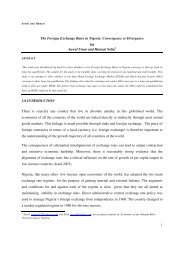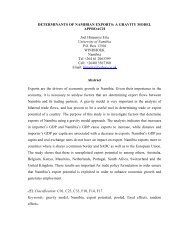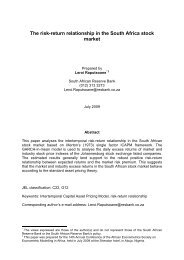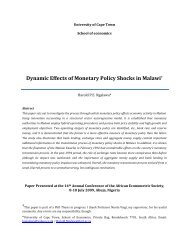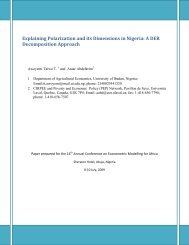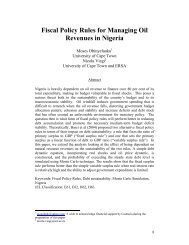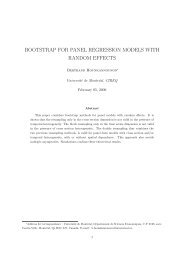Local government revenues and expenditures in Uganda: A VAR ...
Local government revenues and expenditures in Uganda: A VAR ...
Local government revenues and expenditures in Uganda: A VAR ...
You also want an ePaper? Increase the reach of your titles
YUMPU automatically turns print PDFs into web optimized ePapers that Google loves.
identify their spend<strong>in</strong>g priorities first, say, through <strong>Local</strong> Government budget frameworkpapers <strong>and</strong> budget conferences <strong>and</strong> then submit these requests to the Central Governmentfor fund<strong>in</strong>g or raise the requisite fund<strong>in</strong>g necessary to f<strong>in</strong>ance these expenditurepriorities.The “tax-spend” hypothesis implicitly pre-supposes that local <strong>government</strong>s <strong>in</strong> Ug<strong>and</strong>a donot run budget deficits s<strong>in</strong>ce their <strong>expenditures</strong> are aligned to available fund<strong>in</strong>g. This isespecially true <strong>in</strong> Ug<strong>and</strong>a s<strong>in</strong>ce local <strong>government</strong>s have limited access to both public(say, via the issuance of local <strong>government</strong> bonds) <strong>and</strong> private borrow<strong>in</strong>g. Consequently,local <strong>government</strong>s have to prioritize the use of any available f<strong>in</strong>ancial resources whichimproves fiscal discipl<strong>in</strong>e <strong>and</strong> controls the size of the local <strong>government</strong>s’ public deficits.However, <strong>in</strong> the absence of substantial transfers from the <strong>government</strong>, the limited abilityto raise revenue coupled with <strong>in</strong>adequate own revenue sources suggests that severalessential local <strong>government</strong> service delivery <strong>in</strong>itiatives will more than likely be suspended.Our f<strong>in</strong>d<strong>in</strong>gs are consistent with Park (1998) who found evidence <strong>in</strong> support of the taxspendhypothesis for the case of Korea. Our f<strong>in</strong>d<strong>in</strong>gs also reaffirm earlier studies byBuchanan <strong>and</strong> Wagner (1977) <strong>and</strong> Friedman (1978) who argue that <strong>government</strong>s firstraise tax <strong>revenues</strong> before engag<strong>in</strong>g <strong>in</strong> new <strong>expenditures</strong>.6. Conclusions <strong>and</strong> policy recommendationsIn this paper we assess the <strong>in</strong>tertemporal relationship between <strong>government</strong> <strong>expenditures</strong><strong>and</strong> <strong>revenues</strong> for Ug<strong>and</strong>a’s local <strong>government</strong>s. Quantify<strong>in</strong>g this relationship is important<strong>in</strong> as far as underst<strong>and</strong><strong>in</strong>g the role of <strong>government</strong> <strong>in</strong> allocation of resources is concerned.The fundamental premise of this paper is that the “sourc<strong>in</strong>g” of local <strong>government</strong><strong>revenues</strong> precedes the spend<strong>in</strong>g of these <strong>revenues</strong> by local <strong>government</strong> <strong>expenditures</strong> <strong>in</strong>Ug<strong>and</strong>a, which is also known as the tax-spend hypothesis.This objective is achieved <strong>in</strong> several steps. First, us<strong>in</strong>g data for the period 2001-2003from fifty six (56) local <strong>government</strong>s <strong>in</strong> Ug<strong>and</strong>a, we are unable to reject the tax-spendhypothesis. Second, our econometric tests further reveal that while there is a stable longrunrelationship between local <strong>government</strong> <strong>revenues</strong> <strong>and</strong> <strong>expenditures</strong>, there existsunilateral casualty runn<strong>in</strong>g from <strong>government</strong> <strong>revenues</strong> to <strong>expenditures</strong>. Stated differently,local <strong>government</strong>s <strong>in</strong> Ug<strong>and</strong>a face limited risk of budget deficit explosions over the longterm<strong>and</strong> this could be due to the fact that these sub-national <strong>government</strong>s raise funds first<strong>and</strong> subsequently f<strong>in</strong>ance <strong>expenditures</strong>.Our results po<strong>in</strong>t to the importance of align<strong>in</strong>g both local <strong>and</strong> central <strong>government</strong><strong>expenditures</strong> with revenue mobilization capacity. Such alignment will also to improveefficiency <strong>in</strong> the allocation of resources particularly to the growth-enhanc<strong>in</strong>g categories<strong>in</strong>clud<strong>in</strong>g <strong>in</strong>frastructure, health <strong>and</strong> education. The result<strong>in</strong>g control over <strong>expenditures</strong>rather than an <strong>in</strong>crease <strong>in</strong> tax <strong>revenues</strong> will enhance Ug<strong>and</strong>a’s fiscal discipl<strong>in</strong>econsequently foster<strong>in</strong>g an effective medium term budget<strong>in</strong>g framework.7



